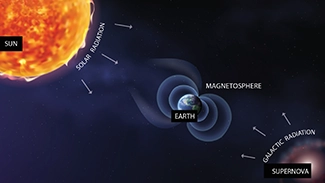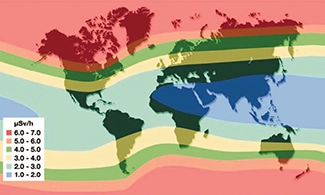Managing aircrew exposure to cosmic radiation
Standards and frequent monitoring help alert aircrew to potential health risks.
By Don Van Dyke
ATP/Helo/CFII, F28, Bell 222
Pro Pilot Canada Technical Editor

Cosmic radiation (CR) is a form of ionizing radiation of particular concern – in our context – for aircrew (pilots, cabin attendants, supernumerary crew, and others) and passengers whose air travels expose them to higher doses of CR than are experienced by the surface-bound public.
Exposure of crew to cosmic radiation and safety measures for aircrew have been a topical issue for many years but are becoming increasingly important for airlines, pilot and flight attendant unions, international organizations and various government bodies.
Surface impact of cosmic radiation
Life on Earth’s surface is protected from the impact of CR by the magnetic fields surrounding the Earth and by its atmosphere.
Much like terrestrial weather, CR intensity (expressed in units called millisieverts or mSv) is extremely changeable, exhibiting day-to-day variability of as much as 100%.
According to US Environmental Protection Agency (EPA) estimates, the average annual dose of cosmic radiation received by individuals on Earth’s surface is 0.33 mSv.
Altitude effects on cosmic radiation
CR is increasingly intense at higher altitudes for aircraft operations, especially those operated at high flight levels and latitudes. Aircraft like the Concorde typically cruised around 60,000 ft. High-performance business jets, such as the Gulfstream G650 and Bombardier Global 7500, can reach altitudes above 49,000 feet for fuel efficiency and smoother rides.
According to FAA AC 120-61B, galactic cosmic radiation (GCR) levels over the polar regions are about twice those over the geomagnetic equator at the same altitudes.
Because solar cosmic radiation (SCR) particle peak energies are much lower than GCR peak energies, SCR dose rates are negligible near the geomagnetic equator.
Two of the most important factors affecting aircraft occupants are altitude and flight duration.
According to the EPA, individuals on a one-way flight from New York to Los Angeles will receive an estimated radiation dose of 0.02 to 0.05 mSv. The ionizing radiation dosage from two such cross-country flights is roughly equivalent to a single chest x-ray (0.1 mSv).
Harmful effects of cosmic radiation
All living things on Earth are exposed to a background level of risks from radiation exposure as detailed in the International Commission on Radiological Protection (ICRP) estimates.
CR is a form of ionizing radiation and is a known carcinogenic (or cancer-causing) risk.
Various studies have found a correlation between acute overexposure to cosmic radiation and the risk of certain types of cancer, although other contributing factors are usually involved.
The World Health Organization (WHO) International Agency for Research on Cancer (IARC) notes that ionizing radiation is a known carcinogen in humans and is also known to cause reproductive problems.
ICRP has concluded aircrew (including pilots, cabin attendants, and similar others) and frequent flyers receive higher doses of cosmic radiation than does the general non-flying public.
Several medical and academic studies link exposure to CR with adverse consequences, including malignant melanoma (skin cancer), leukemia (blood cancer), and prostate cancer.
A 2018 study of more than 5000 US-based flight attendants, published in Environmental Health, found that cabin crew have higher than average rates of certain cancers.
A National Institute for Occupational Safety and Health (NIOSH) study of pregnant flight attendants found that exposure of 0.36 mSv or more in the first trimester may be linked to increased risk of miscarriage and, to a lesser extent, possible birth defects.
Landmark case
In October 2023, the Korea Workers’ Compensation and Welfare Service Labor Panel decided against Korean Air, ruling that there was a causal link between a long-serving former flight attendant’s prolonged period of exposure to cosmic radiation during his career and his death due to stomach cancer in 2021.
The flight attendant had flown on high-altitude polar operations for 25 years, spending roughly 1000 hours airborne annually with nearly half the flights operating long-haul routes to the Americas and Europe.
The airline testified that it had taken reasonable steps in restricting their cabin crew exposure to below legally required limits, limiting radiation exposure to “less than 6 mSv a year,” which is “a lot stricter than the legal maximum radiation exposure standard of up to 50 mSv a year.”
In a later statement to AFT News, the airline stated that “Korean Air strictly manages individual data, and crew members can check their accumulated amount of cosmic radiation exposure, which is updated on a monthly basis.”
The Labor Panel rejected the airline’s defense, concluding that a “considerable” correlation is recognized when considering the victim’s accumulated radiation exposure, which could be higher than measured, and other disadvantageous work environments involving long-haul flight schedules.
The ruling is the first time that an official labor body in South Korea has recognized the correlation between CR and cancer for flight attendants as an industrial death.
In June 2023, South Korea amended a law putting a ceiling on the number of international flights allowed for cabin crew to minimize their exposure to CR.
Monitoring and managing CR exposure
Currently, management of occupational exposure to CR is only recommended where it is likely that aircrew will exceed an exposure of 1 mSv annually.
This limit corresponds to the ICRP 60 and the Canadian Nuclear Safety Commission (CNSC) exposure limit for the public at large.
Advances in technology offer improved real-time monitoring of CR, suggesting that these recommended practices can be transformed into regulatory requirements.

Minimizing CR exposure
In its Briefing Leaflet 19HUPBL01, IFALPA offers several suggestions on how to minimize radiation exposure, including:
• Apply the principle of As Low As Reasonably Achievable (ALARA), making every reasonable effort to maintain exposures to ionizing radiation as far below the dose limits as practical and consistent with the activity.
• Avoid flying above optimum altitude.
• Avoid short-time step climbs.
• Reduce exposure times by flying fewer hours.
• If possible, make use of options regarding selection of aircraft type(s) flown, the types of operation (short haul/long haul), and retirement age.
• Avoid flying close to thunderstorms to reduce the risk of being reached by lightning strikes.
Dose estimation
The goal of dose estimation is to quantify the amount of radiation absorbed by an individual.
Computer models. Computer models are available to estimate CR doses with an accuracy of +/- 10%. These include the European Program Package for the Calculation of Aviation Route Doses (EPCARD), US FAA Civil Aviation Research Institute 7 (CARI 7), and commercial models. However, doses related to solar particle events (SPEs) and solar flares have not yet been taken into account.
Onboard dosimeters. As air transport and business aviation activities continue to increase, exposure of aircrew and passengers to CR is also likely to increase.
The ICRP recently published a strategy which could be developed and implemented for radiological protection from CR in aviation.
In this report, it was recommended that some groups of frequent flyers be managed in a manner similar to those occupationally exposed on a case-by-case basis, while their exposure be considered as the public exposure.
As concrete measures, both aircrew and frequent flyers are encouraged to assess their individual doses regularly and then adjust the frequency of flights as much as possible.
Conclusion
The aviation industry is dealing with several evolving challenges, and one of the most critical is CR exposure for pilots, cabin crew, and passengers.
While many health and safety issues are well understood, cosmic radiation is an area that has gained increasing attention due to its potential long-term health risks.
With flights operating at altitudes where protection from Earth’s atmosphere is significantly reduced, monitoring radiation levels is essential.
The most immediate need is for international standards and regulatory requirements to supplement current guidance for monitoring inflight CR
exposure.
ICAO Annex 6 Part I – Air Transport states: “For each flight of an aeroplane above 15 000 m (49 000 ft), the operator shall maintain records so that the total cosmic radiation dose received by each crew member over a period of 12 consecutive months can be determined.”
ICAO Annex 6 Part II – International General Aviation states: “Aeroplanes operated above 15 000 m (49 000 ft) — radiation indicator. Recommendation — Aeroplanes intended to be primarily operated above 15 000 m (49 000 ft) should carry equipment to measure and indicate continuously the dose rate of total cosmic radiation being received (ie, the total of ionizing and neutron radiation of galactic and solar origin) and the cumulative dose on each flight.”
Some jurisdictions have mandatory laws in place to regulate protection of aircrew members from cosmic radiation exposure. Many regulatory authorities require monitoring and recording of radiation for higher-altitude flights, and there are implications for compliance with local health and safety legislation, such as requiring a risk assessment and taking reasonable practical steps to minimize and control these risks.
ICAO WP A40-WP/345, presented at the Assembly 40th Session in 2019, highlighted the absence of Standards and Recommended Practices (SARPs) regarding aircrew exposure to cosmic radiation on aircraft intended to operate below 15,000 m (49,000 ft).
The working paper identified an opportunity for ICAO to collaborate with the ICRP to develop common guidelines or standards. Hopefully, an updated paper will be introduced at the upcoming ICAO Assembly A42 later this year.
 Don Van Dyke is professor of advanced aerospace topics at Chicoutimi College of Aviation – CQFA Montréal. He is an 18,000-hour TT pilot and instructor with extensive airline, business and charter experience on both airplanes and helicopters. A former IATA ops director, he has served on several ICAO panels. He is a Fellow of the Royal Aeronautical Society and is a flight operations expert on technical projects under UN administration.
Don Van Dyke is professor of advanced aerospace topics at Chicoutimi College of Aviation – CQFA Montréal. He is an 18,000-hour TT pilot and instructor with extensive airline, business and charter experience on both airplanes and helicopters. A former IATA ops director, he has served on several ICAO panels. He is a Fellow of the Royal Aeronautical Society and is a flight operations expert on technical projects under UN administration.
